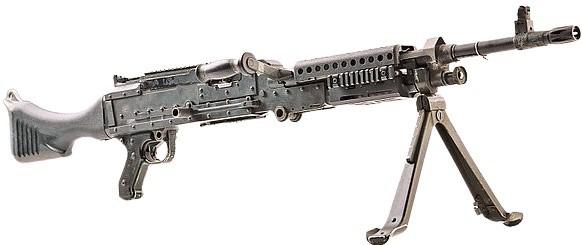
Introduction
The M240 machine gun has cemented itself as one of the most reliable and effective general-purpose machine guns (GPMG) in modern military history. Developed as the FN MAG in the 1950s and later adopted by the United States military, it has played a crucial role in conflicts worldwide.
Origins and Development
The FN MAG: A Belgian Innovation
The story begins in Belgium with the renowned firearms manufacturer Fabrique Nationale Herstal (FN Herstal). In the 1950s, FN engineers, led by Ernest Vervier, developed the FN MAG (Mitrailleuse d'Appui Général)—a machine gun that quickly became the standard-issue GPMG for NATO forces.
Designed around the reliable Browning Automatic Rifle (BAR) long-stroke gas piston system, the FN MAG utilized a belt-fed, open-bolt firing mechanism, ensuring exceptional reliability in adverse conditions. The weapon was chambered for 7.62x51mm NATO, a powerful cartridge known for its accuracy and stopping power.
U.S. Military Adoption and Early Use
By the mid-1970s, the U.S. Army and Marine Corps sought a replacement for the M60, which, despite its widespread use in the Vietnam War, suffered from durability and maintenance issues. After extensive trials, the FN MAG was selected in 1976 as a coaxial machine gun for armored vehicles, replacing the problematic M73 and M219.
By 1997, the U.S. Army adopted the M240B as its standard infantry machine gun, followed by the U.S. Marine Corps' use of the M240G in the early 1990s. This decision marked the beginning of widespread American deployment of the series across all branches of the military.
"The M240 has proven itself in battle from Iraq to Afghanistan, consistently outperforming legacy systems in durability, reliability, and suppressive firepower." — U.S. Army Ordnance Branch Report, 2003
Manufacturing and Production
The M240 has been manufactured in the United States exclusively by FN America (formerly FN Manufacturing) at its Columbia, South Carolina facility since 1984. This facility, a subsidiary of FN Herstal, has produced well over 100,000 variants for the U.S. military and allied forces.
Key Manufacturing Details:
- Company: FN America, Columbia, South Carolina
- Production Start Date: 1984 (series for U.S. military)
- Total Units Produced: Estimated 100,000+
- Materials Used: Steel receiver, polymer stock (some variants), titanium alloy (M240L)
Performance and Tactical Use
Ballistics and Firepower
The gun is chambered for 7.62x51mm NATO, delivering high-velocity firepower with exceptional range and accuracy.
| Specification | M240B (Standard Infantry Variant) |
|---|---|
| Caliber | 7.62x51mm NATO |
| Cyclic Rate of Fire | 650–950 rounds per minute |
| Effective Range (Point Targets) | 800–1,100 meters (tripod) |
| Effective Range (Area Targets) | 1,200–1,800 meters |
| Weight (M240B) | 27.6 lbs (12.5 kg) |
| Weight (M240L) | 22.3 lbs (10.1 kg) |
| Belt Capacity | 50/100/200 round belts |
Key Advantages Over the M60:
- Greater Durability: The steel receiver and robust bolt mechanism provide superior longevity compared to the aluminum receiver of the M60.
- Simplified Maintenance: Fewer moving parts and a more secure barrel locking system eliminate many of the jamming issues that plagued the M60.
- More Reliable Feeding System: Features a belt-driven system with a superior feed mechanism, reducing stoppages under high rates of fire.
Deployment and Global Use
The gun has seen combat in nearly every major U.S. military conflict since the 1990s, including:
- Gulf War (1991)
- Iraq War (2003–2011)
- Afghanistan War (2001–2021)
- Counterterrorism operations in Syria, Africa, and beyond
The weapon is also used by NATO allies and military forces worldwide, including the United Kingdom, Australia, Canada, and Poland.
"The M240 remains one of the most battle-proven machine guns in existence, offering superior firepower over extended engagements." — U.S. Marine Corps Field Manual FM 3-22.68
Variants and Modernization
Key Variants
- M240B (Standard Infantry Variant – U.S. Army, 1997)
- M240G (Marine Corps Variant – early 1990s)
- M240L (Lightweight Titanium Model – 2011)
- M240H (Helicopter-mounted variant)
- M240D (Aircraft and vehicle-mounted variant)
Competition: M240 vs. PKM vs. MG5
| Feature | M240 | PKM (Russia) | MG5 (Germany) |
|---|---|---|---|
| Caliber | 7.62x51mm NATO | 7.62x54mmR | 7.62x51mm NATO |
| Weight | 27.6 lbs (standard infantry version) | 19 lbs | 22 lbs |
| Rate of Fire | 650–950 rpm | 650–750 rpm | 640–850 rpm |
| Effective Range | 1,200–1,800 m | 1,500 m | 1,200 m |
| Durability | Extremely High | High | High |
Conclusion
The M240 machine gun is a testament to ingenuity, durability, and firepower, making it one of the most respected and widely used machine guns in modern military history.
With unparalleled reliability and combat performance, it remains an essential asset for infantry, vehicle-mounted, and aerial support roles. As military technology evolves, the it’s continued modernization efforts, including the lightweight titanium model, ensure its place on future battlefields.
Key Takeaways:
✔️ Unmatched durability and reliability in combat conditions
✔️ More powerful and longer-ranged than smaller-caliber machine guns
✔️ Continuously upgraded for weight reduction and adaptability
The M240’s legacy continues, proving that in the ever-changing battlefield, firepower and dependability remain the keys to success.
For further reading, refer to:
- U.S. Army Technical Manual TM 9-1005-313-10
- NATO Small Arms Ballistics Report (2021)
- FN Herstal Official M240 Specifications
Read more about the this gun here:



If you know of any forums or sites that should be referenced on this listing, please let us know here.


